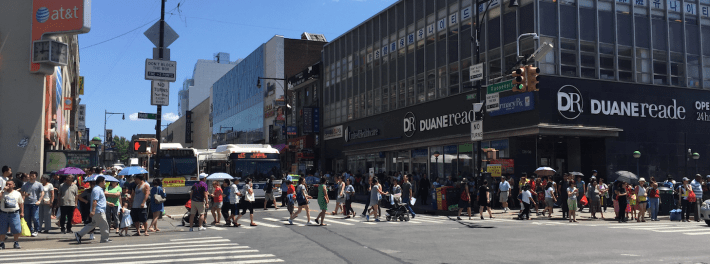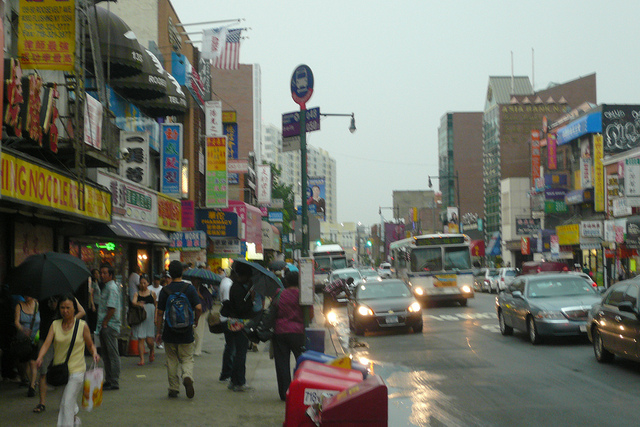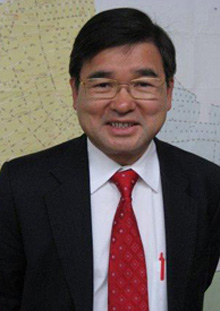Flushing residents want safer streets. If only their city council member cared.
City Council Member Peter Koo's Flushing district sits at the apex of an uptick in driver-induced carnage in Queens, with a 16-percent jump in traffic deaths between 2017 and 2018. Of the 33 pedestrian fatalities in Queens in the first 11 months of 2018, seven occurred in District 20.
Downtown Flushing has some of the city's busiest streets for walking. Despite recent sidewalk expansions, the streets remain designed almost entirely for cars, whose volume is only exacerbated by a seemingly bottomless supply of off-street parking spots. That means a high risk for potential — and potentially deadly — conflicts. In 2017, seven people were killed in the district, including five pedestrians.
As a city council member, Koo is uniquely positioned to push City Hall for action. So far, he's ceded that territory to Assembly Member Ron Kim, a rival in Flushing politics currently running for Public Advocate. After a near-fatal collision on Roosevelt Avenue on Jan. 2, Kim called on the city to "explore all options, including the creations [sic] of pedestrian plazas, on Roosevelt Avenue."
The assembly member didn't cook that idea up by himself. In fact, he got it from Flushing resident Rob Reynolds, whose email entreaties to Koo in 2018 went completely ignored.
"Even that morning, after that woman was mowed over by the car, I forwarded [Council Member Koo] the same email, and he still has not responded," Reynolds told Streetsblog.
(2/2) We need to also prioritize the needs of pedestrians over vehicles in downtown flushing & across our city. I’m calling @NYC_DOT to come back & explore all options, including the creations of pedestrian plazas, on Roosevelt Avenue.
— Ron T. Kim (@rontkim) January 2, 2019
Koo did sign onto Transportation Alternatives "Vision Zero Design Standard" bill [PDF] after the 2013 death of 3-year-old Allison Liao by a driver turning onto Main Street from Cherry Avenue. But he has failed to live up to his commitment to those principles. In 2017, at a neighborhood biking and street safety workshop, he declared himself "against having bike lanes in downtown Flushing."
"Biking is good for your health, it saves gas, it’s good for the environment, but it’s not appropriate in downtown Flushing," he told attendees.

Koo's spokesman Scott Sieber later walked back those comments, but they portend for possible fights over street space in the future. The leadership of Queens Community Board 7 has been loathe to put safer streets on its agenda, according to Greater Flushing Chamber of Commerce Executive Director John Choe, who recently joined the board.
“There’s been a lot of pressure on our elected officials from certain elements in our community to not address these issues and make car access the number one priority," Choe said.
The Greater Flushing Chamber organized the 2017 workshop in cooperation with DOT.
"He was very cooperative in the beginning," Choe said about the council member's role in that event. "Once this issue became more public, it seemed like he was being put in a very difficult position to do the right thing."
The 109th Precinct has shown a similar lack of commitment: When Choe's group met with precinct officials about NYPD personnel parking their personal vehicles on neighborhood sidewalks, officers told them the illegal parking was necessary for terrorism prevention.
"They seemed to think it was a joke," Choe told Streetsblog.
Still, advocates are still hopeful for a turnaround.
"Council Member Koo says he’s supportive, but he’s not really doing more to protect [people]," said Amy Liao, Allison's mother. "We want to work with him to make his district one of the safest, and I want to hold him to that."
For the record: Council Member Koo declined an interview request from Streetsblog. Instead, his spokesman sent over the following statement:
We’ve worked with DOT on a number of improvements centered on the downtown Flushing area over the last several years. These include a complete reconstruction of Main Street, wider sidewalks up to nine feet to make it safer for pedestrians, new crosswalks, pedestrian islands, street repavings, bus lanes, traffic signals, adjustments to traffic signal timings, and more restrictive traffic patterns that prioritize pedestrian crossings. Last year, I also introduced Intro 1806, which would make it a requirement for the DOT to consider all-way traffic stops and leading pedestrian intervals at intersections as part of its studies of fatal or serious pedestrian crashes.
At the end of the day, the intersection of Roosevelt and Main Street is statistically one of the busiest intersections in New York City for both pedestrians and vehicle traffic, and we will continue working with the DOT, 109th Precinct, the Community Board and all stakeholders to ensure drivers and pedestrians are educated and informed about the need to travel safely.
Koo's statement hardly reflects a proactive approach. All-way traffic stops and leading pedestrian intervals can be valuable tools, but they're hardly a panacea for a neighborhood-wide crisis. For many intersections, they aren't even possible.
The Main Street sidewalk expansion project, meanwhile, was an important step. As anyone who's walked in the neighborhood recently can tell you, they failed to solve the core problem of not enough room to walk.
"This is Main Street," said Reynolds. "This is a busy street with a lot of cars going by constantly, and literally half of the curbside lane is filled with pedestrians."







